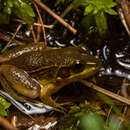en
names in breadcrumbs


Unknown to science until 1982, the rare Florida Bog Frog, Lithobates okaloosae, was first described from Malone Creek, Okaloosa County, in the western Florida panhandle.This is a very local endemic species, known only from adjoining parts of Okaloosa, Santa Rosa and Walton counties.Experts estimate that it occurs within an area 7.7 mi2 (20 km2) in size.Most of the documented sites (90%) are within the Eglin Air Force Base grounds.
Moderate in size, the Florida Bog Frog has the distinction of being the smallest North American species in its family (Ranidae).From nose to tail (snout vent length) males measure on average 1.58 inches (40.2 mm).Females are slightly larger (41.5 mm).It is light brownish-green in color, with a lighter-colored stripe down the ridges on each side of its back.Its face and throat are yellow, and it has copper-brown colored irises.
The Florida bog frog inhabits shallow, slow-flowing waters in acidic bogs, ponds, creeks and seeps along tributaries of the East Bay, Shoal and Yellow Rivers.This frog lives in early-successional, rather than mature, habitats so is dependent on disturbance (especially forest fire) to maintain its habitat from getting overgrown.Florida bog frogs occur amongst herbs, forbs, grasses, and lichens often in association with sphagnum moss beds and sparse woody vegetation including titi (Cyrilla racemiflora) trees, and Atlantic white cedar trees.
Monitoring shows that L. okaloosae adults stay within a very local home range extending on average 187 m2 (0.05 acres). In a day, individuals generally move less than 6.6 feet (2 m).They breed March-September.From water 1.4 inches (3.5 cm) deep,
males advertise for females with a series of pulses described as a rattling train. Males appear to choose calling sites appropriate for egg deposits, as females lay 150-300 eggs very close by (within an average of 14 centimeters of calling site).Females produce a small, sticky eggmass that floats on the water surface, sometimes sticking to vegetation or the stream bank.Tadpoles hide in algae mats in slow, shallow water with complex vegetation, presumably to avoid predators, such as the banded water snake (Nerodia fasciata) and the red fin pickerel (Esox americanus). Tadpoles overwinter, and metamorphose into frogs the following spring.
The International Union for Conservation of Nature (IUCN) lists L. okaloosae as a vulnerable species.The Florida Fish and Wildlife Conservation Commission (FWC) lists it as threatened on the Florida Endangered and Threatened Species. Its highly restricted range makes the Florida bog frog particularly vulnerable to extinction.Degradation and development of its sensitive environment is the greatest threat to this species’ survival, although it does appear to tolerate some habitat disturbance, including silted streams.
In addition to habitat decline, the Florida bog frog is susceptible to disease outbreak.Testing shows sub-lethal levels of chytrid fungus (Batrachochytrium dendrobatidis) infection across its populations.This fungus has decimated populations of amphibians world-wide.Ranaviruses also present major concern.Furthermore, climate changes could have a drastic effect on Florida bog frog populations, as it would not tolerate drought or inundation of streams from rising ocean levels.
The Florida bog frog is one of seven species in the clamitans section of genus Rana.It is distinguished from its slightly larger, closely related sister species the bronze frog (Lithobates clamitans) by the degree of webbing on its toes, morphology of the vocal cords, and distinctive calls.Genetic analyses indicate that overlapping populations of the widely distributed L. clamitans and L. okaloosae sometimes interbreed.“Genetic swamping,” whereby the Florida bog frog’s genes are overwhelmed by breeding with the common bronze frog, is another significant threat to the survival of Florida bog frogs.
(Austin et al. 2011; Austin et al. 2003; Moler 1985; Hammerson et al. 2004; Florida Fish and Wildlife Conservation Commission 2013)